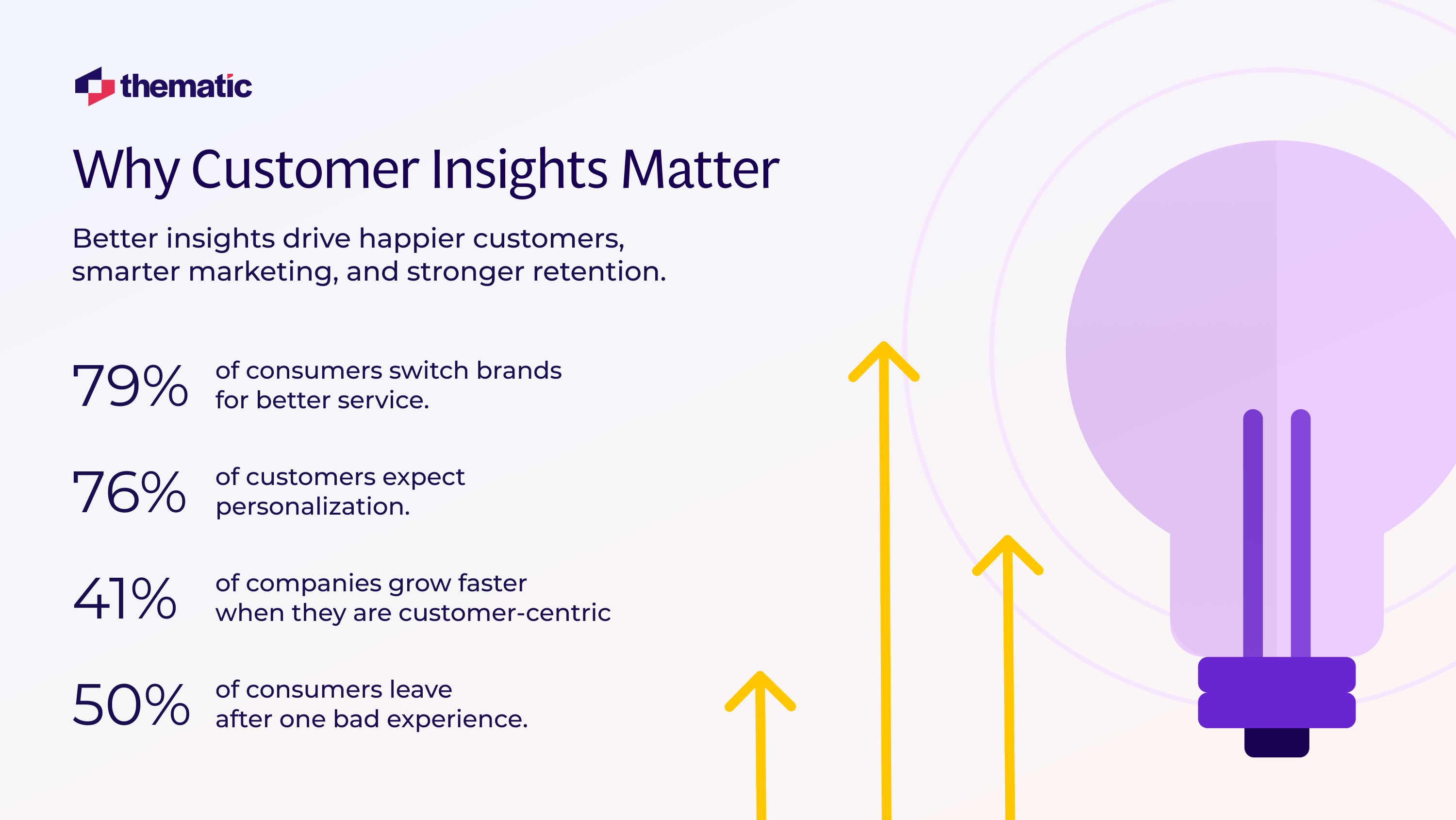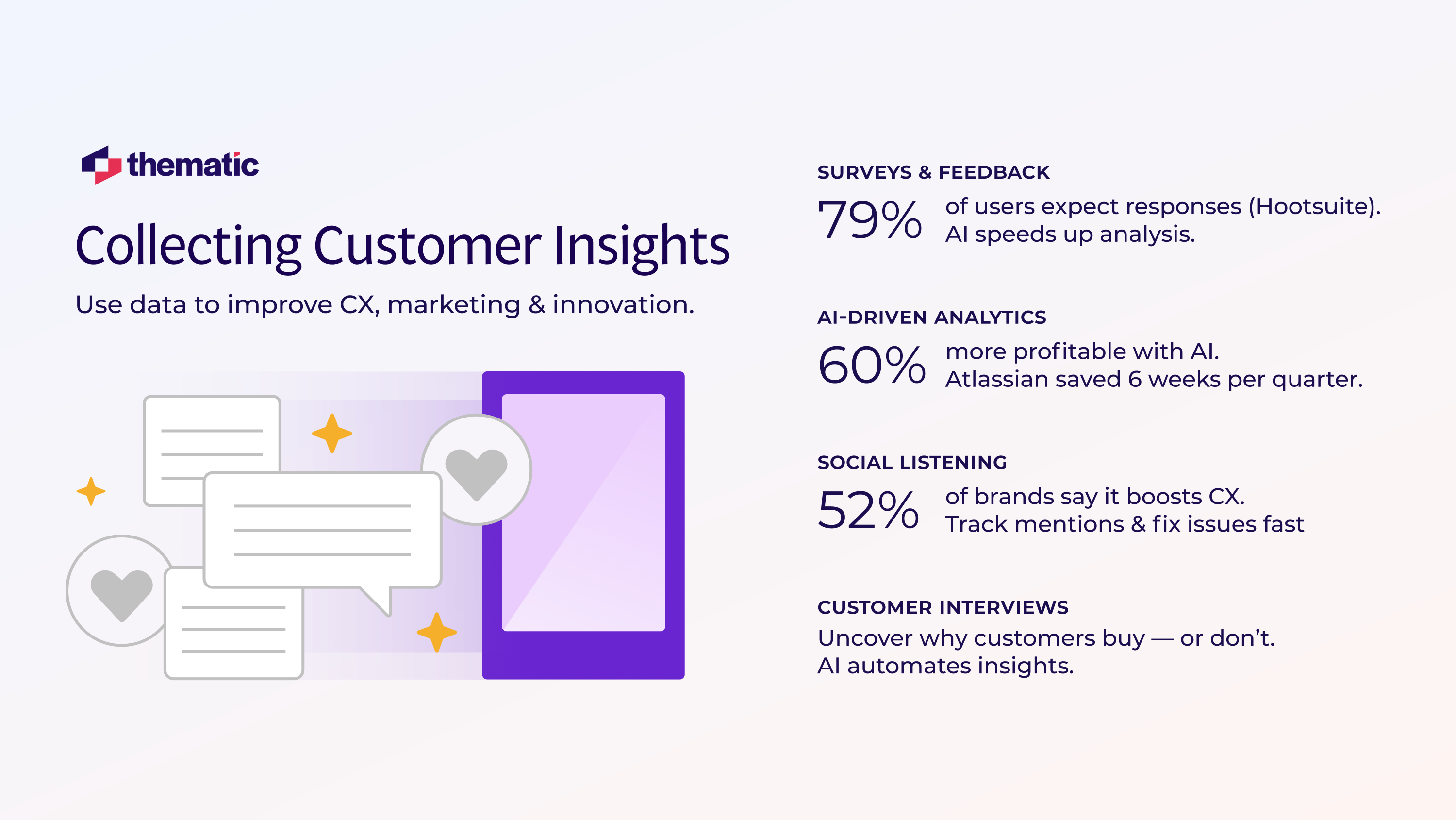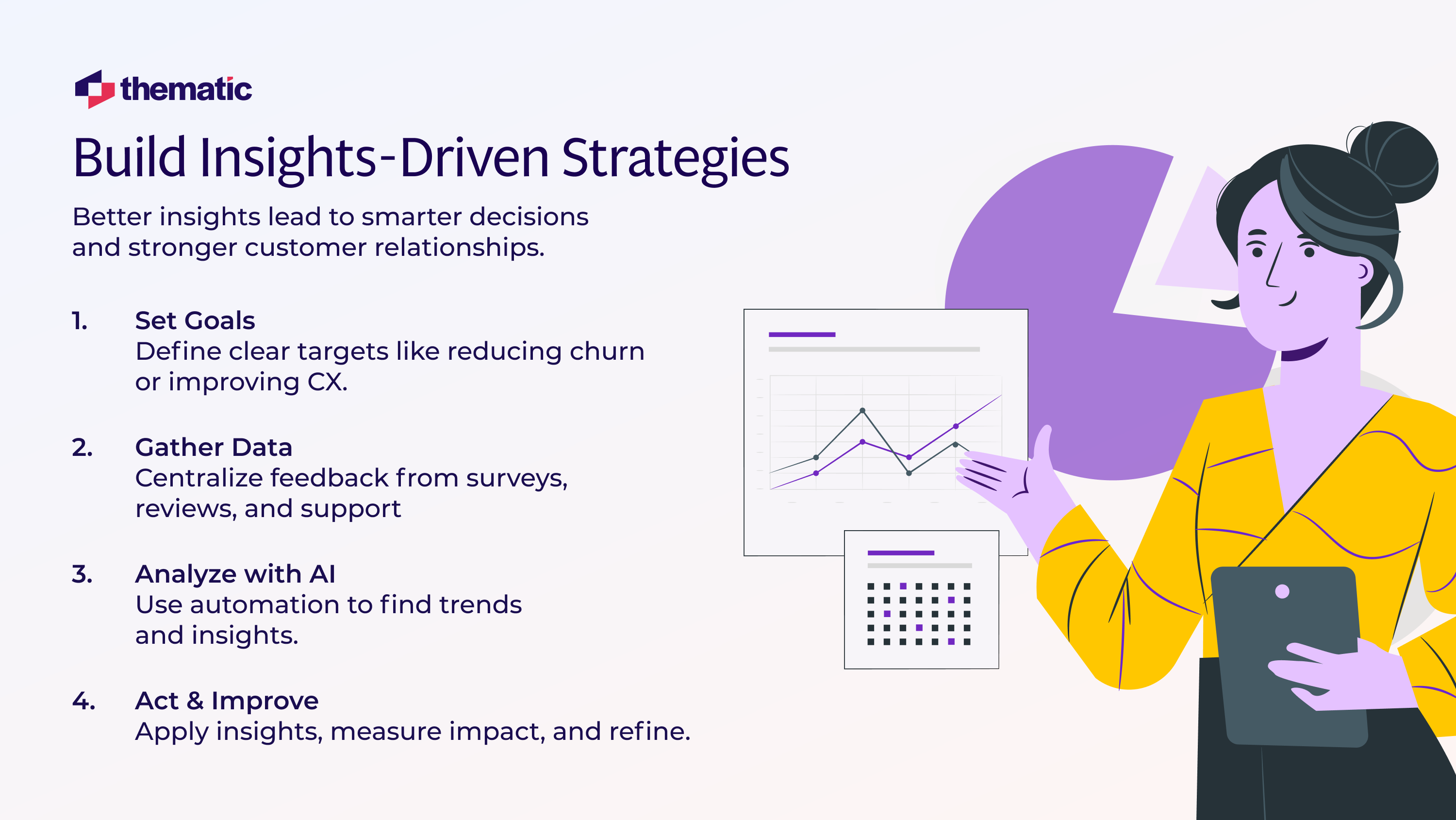
Learn what customer insights are, how to collect them, and how businesses use them to improve customer experience and strategy.

Imagine losing 73% of your customers simply because they had a bad experience with your brand. That’s the reality today—over half of consumers will switch to a competitor after just one negative interaction. This staggering statistic highlights why businesses must prioritize customer insights and invest in analysis tools to understand their audience better.
So, what are customer insights?
Customer insights are actionable understandings derived from customer data that help businesses improve their strategies. Unlike raw data, insights interpret patterns and emotions behind customer behavior, enabling brands to make informed decisions.
Why should your business rely on customer insights? Because it will help:
In this guide, we’ll explore what customer insights are, why they matter, and how businesses can use them to improve strategy, marketing, and customer experience.
We’ll also dive into AI’s role in customer insights, common challenges businesses face, and practical steps to build an insights-driven strategy.
So, let’s go!
As we said earlier, customer insights are valuable discoveries about what customers want, how they behave, and why they make certain decisions. They help businesses move beyond just looking at numbers to actually understanding what drives customer actions.
To put it simply, raw data is just facts and figures—like the number of visitors on a website. Customer insights analytics organizes that data into trends, like how many visitors leave a page without making a purchase. Customer insights, however, go deeper—they explain why visitors leave, such as slow load times or unclear pricing.
Imagine an online store tracking website visits. The raw data might show 10,000 visits per day. Consumer analytics might reveal that 70% of visitors leave without buying. But customer insights—gathered through customer experience insights and customer review analysis—could uncover that customers leave because they find shipping costs too high or the checkout process too complicated.
With these insights, businesses can take action—like offering free shipping or simplifying checkout—to improve sales and retention. In short, customer insights turn data into meaningful, business-changing decisions.
Customer insights are essential for businesses to improve customer satisfaction, drive better marketing decisions, and make smarter, data-driven customer insights. As we mentioned in the beginning, without understanding customer behavior, Zendesk reports companies risk losing business—73% of consumers will switch to a competitor after multiple bad experiences.
Let’s talk about the reasons why customer insights are important.
Good customer experience insights can transform a company’s relationship with its audience. Zendesk reports that 79% of consumers would switch brands if they found a company with better customer service. By analyzing feedback and behavior patterns, businesses can proactively address pain points, reduce churn, and build lasting relationships.
Take the case of Instacart as an example. This company used Thematic to analyze data and gain customer insights, helping them improve multi-segment experiences, address app crashes, and resolve fulfillment issues. By tracking real-time feedback, they quickly fixed major pain points, improving satisfaction across shoppers, retailers, and advertisers.
Marketing efforts are more effective when informed by customer insights. In fact, 76% of customers expect personalization, and brands that succeed in this area are 71% more likely to improve customer loyalty. Understanding what customers want ensures campaigns resonate, leading to higher engagement and conversion rates.
DoorDash used customer insights to uncover that work flexibility was a key driver of Dasher retention. They adjusted their marketing campaigns to highlight flexibility, leading to higher engagement and loyalty.
Companies that embrace data-driven customer insights gain a competitive advantage. Customer-obsessed organizations report 41% faster revenue growth than those that are not. These insights help businesses identify trends, refine products, and deliver services that align with evolving customer needs.
Besides, innovative products start with understanding customer needs. Businesses that actively listen to customer feedback can spot emerging trends and unmet needs, leading to more successful product launches. For example, customer review analysis can reveal features customers love—or wish they had—guiding future development.
Atlassian is a good case in point here. They used AI-driven insights to prioritize product improvements, saving six weeks per quarter on manual feedback analysis. This allowed them to improve features based on real customer needs.
Customer retention is critical; we said it before, and we say it again—more than half of consumers will leave a brand after just one bad experience. Companies that track customer insights can identify churn risks early and take action.
In the case of LendingTree, they analyzed customer feedback and discovered that late-night lender calls were a major churn factor. By adjusting their outreach strategy, they reduced complaints and increased customer engagement.

Understanding customers starts with collecting the right insights. Businesses today use a mix of traditional methods and AI-driven tools to uncover patterns, measure sentiment, and refine strategies. Below are four key methods for gathering data-driven customer insights effectively.
Surveys and feedback forms are among the most direct ways to gather customer opinions. They allow businesses to measure satisfaction, track trends, and identify pain points over time.
According to a Hootsuite survey, 76% of consumers expect brands to respond to their feedback—yet many companies fail to close the loop effectively. Without follow-ups, businesses risk losing valuable trust and loyalty.
Using open-ended survey questions helps capture detailed qualitative feedback, but analyzing these responses can be time-consuming. This is where text analytics and AI-powered coding qualitative data tools come in, allowing businesses to process large amounts of customer input efficiently.
Customers freely share opinions online—on social media, review platforms, and forums. Social listening tools track mentions, hashtags, and customer sentiment across digital channels, offering real-time insights into customer preferences and concerns.
This is a worthwhile endeavor, with 52% of brands say social listening has helped them improve customer experience.
Here’s an example of how it’s done: A restaurant chain monitoring online reviews might notice that customers frequently mention slow service during lunch hours. By tracking and analyzing these comments, the business can address operational inefficiencies and improve customer experience insights.
While surveys provide structured data, one-on-one interviews, and focus groups offer deeper insights into customer motivations and emotions. These methods are particularly useful for:
However, interviews require significant time and resources to be conducted at a certain scale. Many companies now use AI-powered transcription and analysis tools to automate coding qualitative data and extract key themes faster.
AI-driven text analytics is revolutionizing how businesses analyze customer feedback. These tools process unstructured text from surveys, social media, chat logs, and online reviews, identifying trends and patterns without manual effort.
Remember that customer-centric companies are 60% more profitable than those that don’t prioritize customer insights.
So, how does using AI for qualitative data analysis help business? They can:
Remember Atlassian? They implemented AI-powered text analytics to analyze feedback across multiple products. This helped them prioritize feature improvements, reducing manual analysis time by six weeks per quarter.

As businesses collect vast amounts of customer feedback, making sense of it efficiently is a challenge. Traditional methods, like manual surveys and human-led analysis, are time-consuming, prone to bias, and difficult to scale.
This is where AI, such as natural language processing (NLP) large language model (LLM), and big data come in. They allow sentiment analysis that generates customer insights through tools like Thematic. With all these, businesses extract meaningful insights from raw data.
Traditional customer insight methods rely on a manual review of survey responses, focus group transcripts, and support tickets. While valuable, this approach:
In contrast, AI-driven customer insights allow businesses to:
AI and machine learning algorithms detect patterns, sentiment shifts, and emerging customer concerns at scale. Businesses that use AI for insights can:
A powerful example of AI's accuracy and efficiency comes from a study showing that:
“AI algorithms, including machine learning and deep learning models, enhanced fault detection accuracy by an average of 30% compared to traditional manual inspection methods.”
This demonstrates how AI outperforms traditional analysis, not just in speed but also in precision. Similarly, in customer insights, AI can pinpoint pain points, sentiment trends, and CX issues far more accurately than human teams alone.
Why do AI-powered insights matter?
Because companies using AI-powered customer insights make smarter decisions, optimize CX, and reduce churn faster than those relying on manual analysis.
By embracing AI and big data, businesses can turn customer feedback into real-time, actionable insights, leading to better products, stronger loyalty, and higher growth.

AI-powered software to transform qualitative data into powerful insights that drive decision making.
Customer insights are not just about collecting data; they drive real business growth by helping companies optimize customer experience (CX), validate product features, and personalize marketing efforts.
Below are three key ways businesses can leverage insights supported by real-world case studies.
Customer insights help companies identify and resolve pain points, leading to higher retention, fewer complaints, and improved customer loyalty.
In the case of Watercare, after major storms disrupted its infrastructure, the company faced a surge in customer complaints. Using Thematic’s AI-powered insights, Watercare was able to analyze voice of customer (VOC) data in real time, allowing them to:
✔ Prioritize urgent issues to restore service faster.
✔ Improve customer communication during crisis events.
✔ Enhance customer trust through transparency and responsiveness.
Clearly, companies can use customer insights to improve CX, even in crisis situations.
Customer insights help companies validate product features, ensuring they develop solutions that align with user needs.
Here’s a case in point: Melodics, a music education platform, struggled with prioritizing feature development. By using Thematic’s AI-driven text analytics, the team identified what customers actually needed versus what they casually mentioned. The insights allowed them to refocus development on the most impactful features, reducing engineering costs and improving retention.
This case proves that businesses can use AI-powered insights to guide product innovation and reduce wasted resources.
Customer insights also fuel personalized marketing campaigns, leading to higher engagement and conversion rates.
DoorDash used customer review analysis to understand what kept delivery drivers (Dashers) engaged. Insights revealed that work flexibility was a top priority, leading to personalized messaging in marketing campaigns. As a result, Dasher retention and engagement significantly improved.
This case showcases how companies can use customer insights to tailor marketing efforts, increase engagement, and reduce churn.
While customer insights are critical for business success, many companies struggle to collect, interpret, and act on them effectively. Below are some of the most common challenges businesses face when analyzing customer data—and how AI-powered tools can help overcome them.
One of the biggest hurdles in gaining accurate customer insights is dealing with biased or incomplete data. Traditional surveys and feedback forms often capture only a small portion of the customer base—usually the most satisfied or dissatisfied customers. This creates an incomplete picture of the overall customer experience.
Solution: AI-powered sentiment analysis and text analytics can process unstructured feedback from multiple sources, such as online reviews, social media, and support tickets. This ensures a more representative and unbiased dataset for analysis.
Understanding what customer insights are means going beyond raw data to extract meaningful patterns. However, human-led analysis is often subject to bias—teams may interpret feedback based on assumptions rather than actual data trends.
Example: A product team may believe that customers dislike a new feature, but deeper analysis may reveal that they simply don’t understand how to use it. Without the right tools, businesses risk making the wrong decisions.
Solution: AI-powered text analytics eliminates human bias by identifying patterns, sentiment shifts, and recurring themes in customer feedback. These tools quantify customer concerns objectively, making it easier for businesses to take the right action.
Many businesses struggle with fragmented customer data spread across different teams—marketing, sales, customer service, and product development. When insights are not shared, businesses miss out on valuable opportunities to improve CX.
Example: Atom Bank initially struggled with siloed customer feedback across seven different engagement channels, leading to disjointed customer experiences. By integrating all feedback into one AI-powered customer insights platform, they achieved:
Solution: AI-powered feedback analysis tools integrate data across multiple sources, allowing teams to work from a single source of truth. This enables faster decision-making and better cross-functional collaboration.

A customer insights-driven strategy helps businesses understand customer needs, optimize experiences, and drive growth. Follow these steps to turn insights into action and improve decision-making.

Before gathering insights, identify what you want to achieve. Clear goals ensure that data collection and analysis align with business priorities.
How to do it:
Customer insights come from multiple sources—surveys, social media, reviews, customer support tickets, and website behavior. Integrating all data in one system provides a holistic view.
How to do it:
Raw data isn’t enough—businesses need AI-driven tools to identify trends, detect pain points, and predict customer behavior.
How to do it:
A strategy is only effective if insights lead to real improvements. Businesses need a structured feedback loop to track results and refine strategies.
How to do it:
Understanding what customer insights are is more than just gathering data—it’s about using that data to drive real business success. Companies that harness AI-powered analytics to uncover trends, improve CX, and personalize experiences stay ahead of the competition.
It is important to develop strategies and build a customer insights framework—a structured approach to analyzing customer behavior, segmenting the audience, and applying learnings to enhance products or services.
By following a customer insights-driven strategy, businesses can:
✔ Enhance customer experience by identifying and fixing pain points.
✔ Develop better products based on real customer feedback.
✔ Create personalized marketing campaigns that drive engagement.
✔ Reduce churn and build long-term customer loyalty.
Thematic makes it easy to turn customer feedback into actionable insights. Its AI-powered platform helps businesses extract real meaning from text data—fast, accurate, and scalable.
Ready to see the power of AI-driven customer insights?
Try Thematic on your own data today!
Customer insights should be analyzed continuously, but the frequency depends on business needs. Real-time analytics help track immediate trends, while monthly or quarterly reviews ensure long-term strategic improvements.
Market research focuses on broad industry trends and competitor analysis, while customer insights come from direct feedback, revealing specific customer needs, behaviors, and pain points.
Absolutely! Many AI-driven text analytics and sentiment analysis tools are now accessible to small businesses, helping them extract meaningful insights from customer feedback without requiring large research teams.
Analyzing feedback can reveal pricing concerns, willingness to pay, and competitor comparisons. Businesses can use these insights to adjust pricing, introduce promotions, or refine value propositions to increase conversions and retention.
Join the newsletter to receive the latest updates in your inbox.